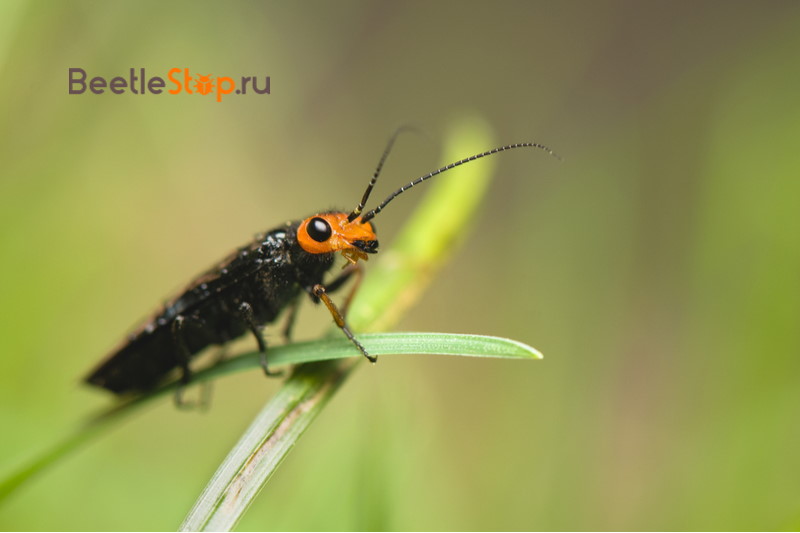Red-headed sawfly weaver - enemy of pine trees in forests and landings
The family of spider weaver sawflies includes 300 species. Beetle larvae are dangerous tree pests. The red-headed sawfly weaver develops in the pines. His offspring arranges spider web nests on the branches, feeds on needles. With massive outbreaks of reproduction, large areas of pine forests are affected. Insects are being monitored to prevent them. To destroy the pest allows chemical treatment of trees.

Morphological description of the species
The red-headed sawfly weaver (Acantholyda erythrocephala) is a bug from the family of spider sawflies. The body is wide, flattened. Fully venated wings, transparent, but with blackout. Body color is blue-black. The head is movable, long antennae are bristle-shaped. The eyes are facet, the mouth apparatus is gnawing. Crescent-shaped mandibles. The legs are black, on the forelimbs there is one spur, the color of the lower leg and thigh end is brownish.
Sexual dimorphism
The weaver’s imago is distinguished by the color of the head, in the female it is bright red, in the male the face up to the antennae is yellow, the rest is black. Females are larger than partners, their size is 10-14 mm, males - 8-10 mm.
Distribution area
Acantholyda erythrocephala sawflies are found in Northern and Central Europe, Ukraine, Kazakhstan. The phytophage was introduced to North America in 1925. In the northern states and Canada, a red-headed weaver is the main pest of white pine. The European part, Siberia, Altai and Krasnoyarsk Territories are the habitat of the sawfly in Russia.
Lifestyle
The pest is found in pine forests, groves, artificial plantings. Damage to adult trees aged 15-20 years. Beetles appear in late April. Immediately begin mating. Life expectancy of adults is small, about 1 month. One-year development generation. Some of the larvae fall into a two or three-year diapause. They are called eonymphs. Up to a third of the larvae are in this state. Their late transformation into imago creates the appearance of continued development.
Information. Pronymphus differs from eonympha by the presence of dark spots on the head, located at the site of future eyes of the beetle.
Beetle propagation and larval development
The adult years begin at the end of April and continue until June. after mating, females lay eggs on old needles. The eggs are cylindrical in shape, 2-5 mm long. initially yellow, gradually darken, turning into brown. Stacked in a row of 3-8 pieces. The total fertility of the female is 30-40 eggs. Embryo development occurs in 10-14 days.
The body of the larva is cylindrical, similar to a caterpillar. After birth, it is pink, the head is yellow. The length of the female is up to 28 mm, the male is 18 mm. The color of the adult larva is green; there are brownish and yellowish spots. On the sides are longitudinal dark stripes. Head yellow or brownish, covered with a dense chitin capsule. Antennae 8-segmented. Three pairs of limbs are attached to the thoracic segments, the abdominal legs are absent. On the last segment of the abdomen are 3-segmented cerci. After birth, live in groups of 10-15 pieces. Build spider webs.
Information. Larvae feed on old needles; they pass to young needles only in the absence of other food.
After 2 links, they begin to live separately in their own web covers. They gnaw at the needles and drag them into a case for eating. The nest is quickly clogged with waste products. The total maturation of a red-headed weaver is about a month. In the process of development, the larvae turning into males pass five ages, the future females molt once more and replace six ages.
At the end of June, they descend from the trees to complete the development of the earth. Larvae that have turned into pronimph winter in the soil at a depth of 4-10 cm. In the fall, they build cradles - turning with their whole body they get a small chamber of oblong ovoid shape. From the inside, the cell walls are smeared with secretions. It turns out a smooth surface that does not damage the delicate integument of the pupa. Stacking in the winter diapause, the larva bends its head to the abdomen.
Information. Up to 350 red-headed weaver larvae can winter under one tree.
Pupation occurs next spring. Pupa free, greenish. It darkens over time, becomes blue. The duration of the pupal phase depends on soil temperature. On average, it is 2 weeks. For pupae 8-12 mm. Sexual differences are noticeable in them - a saw-shaped ovipositor of females and genital tweezers on the last abdominal males.
After exiting the earthen cradle, the adults stay on low plants for several days, making test flights. Then they climb the pine branches.
Forest pest management methods
The vital activity of the offspring of the red-headed sawfly does not kill trees, but weakens them. Sick pine trees are defenseless against diseases and dangerous insects, such as bark beetles. Outbreaks of pest breeding last up to 8 years. They can stop at any time as a result of the death of eonymphs in diapause. Weavers are regularly monitored. In the second half of June, the number of spider nests on pine branches is counted. The second method of control is digging and studying eonymf. The number of sick individuals, the ratio of males and females are taken into account.
During periods of mass reproduction of insects, significant areas of coniferous stands suffer. Insecticides are used to destroy weaver larvae. Organophosphorus substances and pyrethroids are used. Processing is carried out on the larvae of younger ages. It is recommended that forestry activities be carried out: plowing of the cutting area, creation of areas with deciduous trees in the forests, installation of mixed, closed stands. As biological measures, insectivorous birds, red ants and horseworms are involved.

